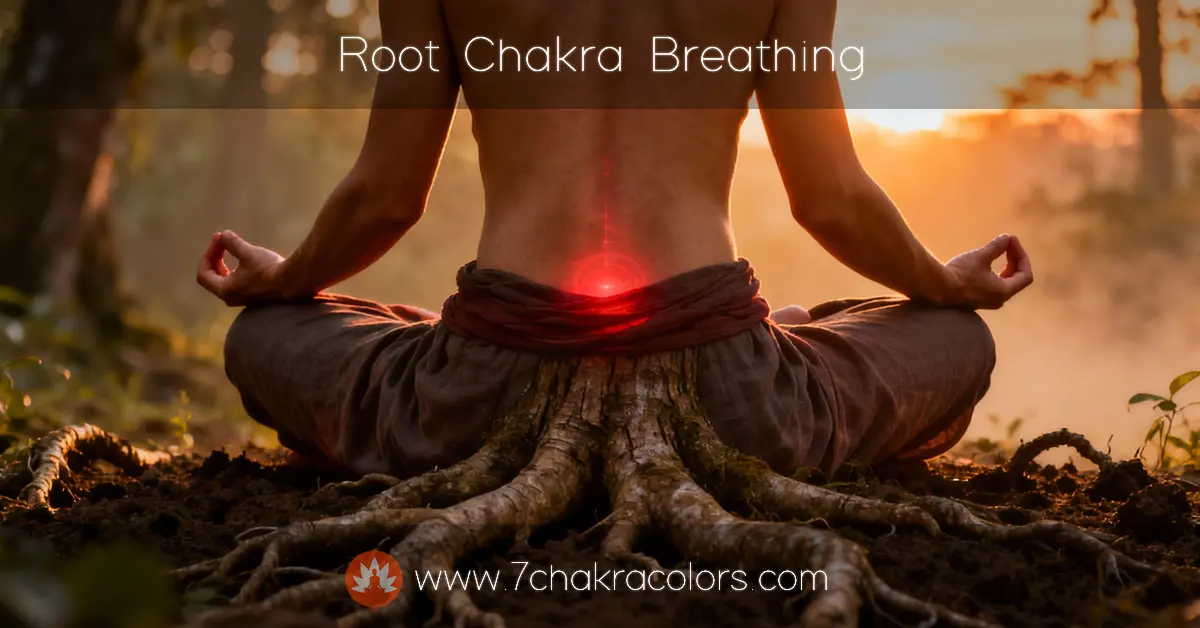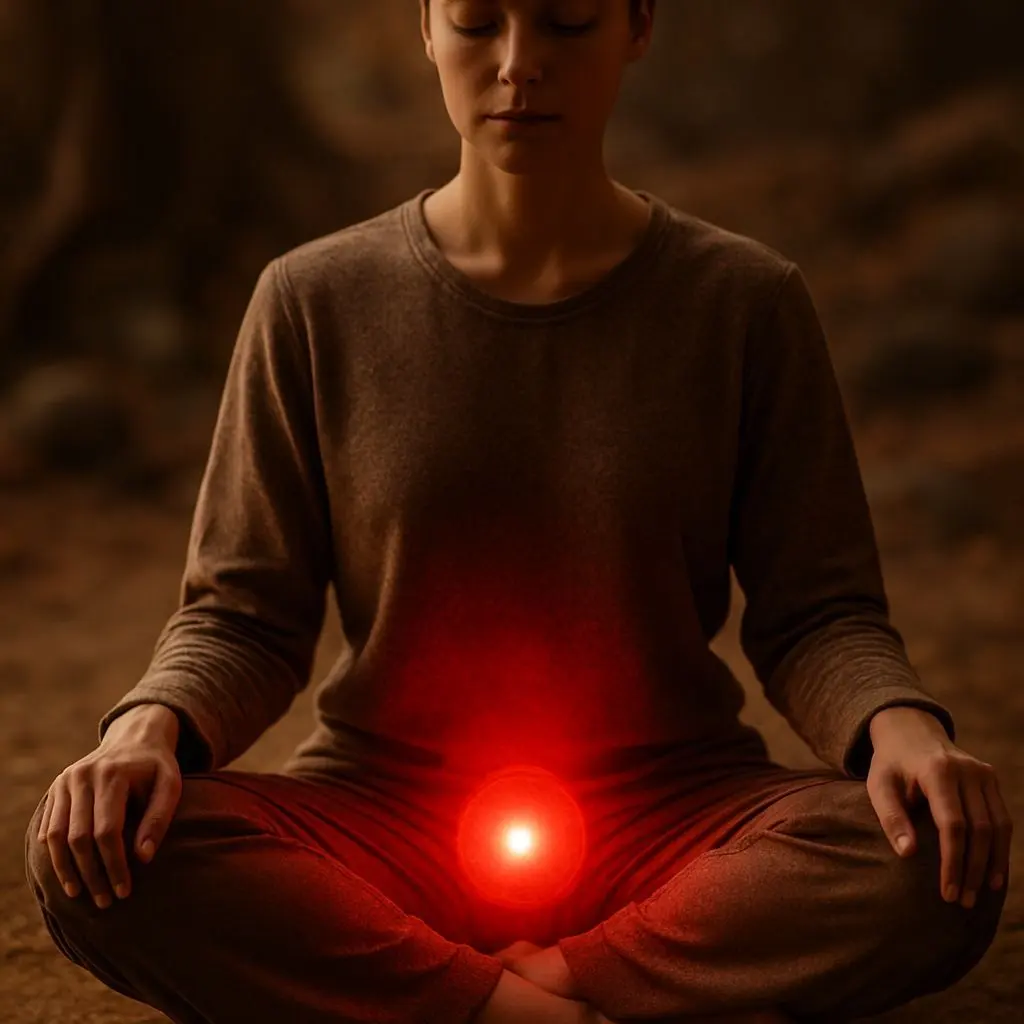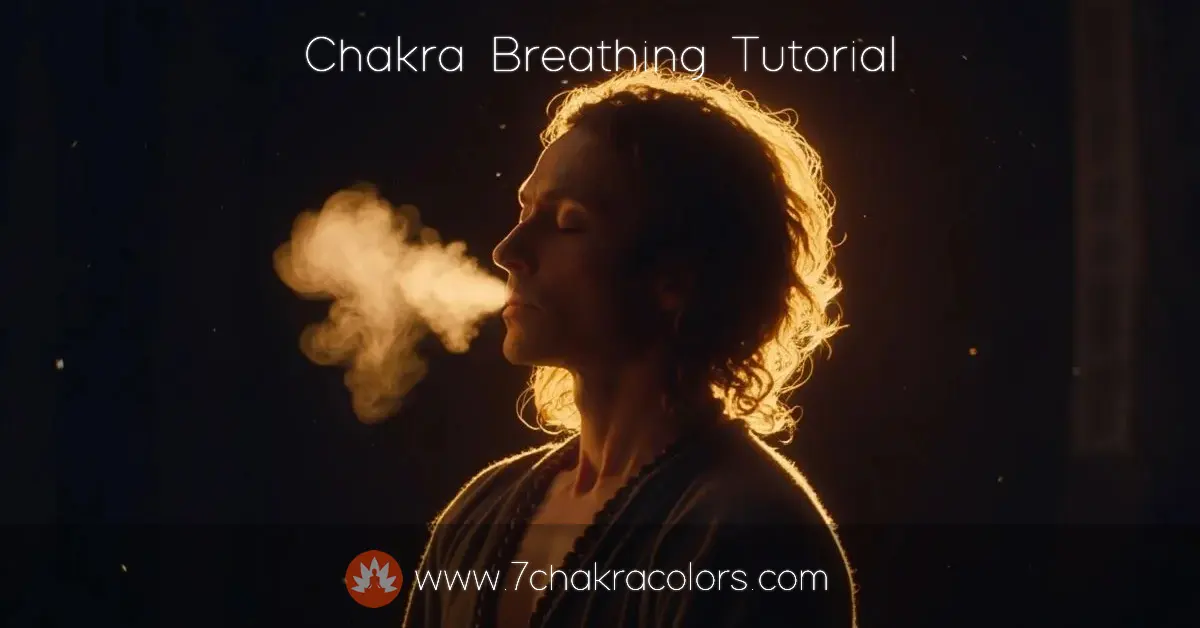

Learn powerful root chakra breathing techniques that ground you in minutes. Discover pranayama methods, visualizations, and daily practices for stability and calm.
Your root chakra sits at the base of your spine. Right there at your tailbone. When it's blocked or weak, you feel scattered - anxious, ungrounded, like you're floating through life without an anchor.
Root chakra breathing changes that. These techniques pull your energy down, connect you to earth, make you feel solid again. Not someday after months of practice. Right now.
Here's what you'll learn:
To learn some general breathing techniques that work for all seven chakras, read our main chakra breathing guide.
The root chakra - Muladhara in Sanskrit - handles your foundation. Safety. Security. That bone-deep sense that you're okay, you belong here, you can handle what comes.
It sits at the bottom of your spine, near your tailbone. Associated with red energy and the earth element. When it's working right, you feel stable. Grounded. Present in your body rather than stuck up in your head worrying about everything.
When it's blocked? Different story.
You'll notice anxiety that won't quit. Fear without a clear source. That disconnected feeling where you're going through the motions but not really here. Some people get overly cautious - afraid to try anything new, make any changes. Others feel restless, unable to settle anywhere or commit to anything.
When your root chakra is out of balance, there are signs. Your body tells you when energy isn't flowing right through your root chakra. Chronic lower back pain. Issues with your legs, feet, or knees. Fatigue that sleep doesn't fix.
Digestive problems show up here too - your root chakra connects to your colon and elimination. The body stores stress in this area, and that manifests physically.
Breath moves energy. Not metaphorically - actually moves it.
When you direct your breath to your root chakra with intention, you're pulling prana down from where it's stuck. Usually your energy gets trapped up high - chest, throat, head. Racing thoughts. Shallow breathing. Disconnection from your lower body.
Root chakra breathing techniques reverse that pattern. They send life force down to your foundation, wake up dormant energy there, create that solid feeling of being planted firmly on earth.
Start here. This works whether you've meditated for years or tried it once and gave up.

Sometimes the shift happens immediately. That scattered feeling settles. Your breath naturally deepens. You feel heavier in a good way - like you're taking up space instead of apologizing for existing.
Other times it takes a few sessions. Stick with it either way.
Also called Sama Vritti. Equal breathing. This one creates immediate stability because you're balancing everything - inhale, hold, exhale, hold. All the same duration.
This breath calms your nervous system fast. Reduces anxiety. Creates that grounded feeling when you're spinning out. Use it before anything stressful - meetings, difficult conversations, random Tuesday afternoon panic attacks.
This one's more intense. Rapid, forceful breathing that clears blockages and wakes everything up.
Bhastrika activates stagnant energy. Use it when you feel stuck, depressed, unable to take action. It pushes through that heavy, immobile feeling.
This balances your entire energy system while grounding you. Perfect for meditation practice when you need to settle your mind before going deeper.
Your nervous system loves this. The left-right alternation calms racing thoughts, and directing it to your root chakra pulls that calm energy down where it matters.
Your mind can't tell the difference between a vivid visualization and reality. Use that.
This one works when you're feeling particularly ungrounded. That disconnected sensation where you're not sure where you belong.
Sound amplifies breath work. The seed sound for your root chakra is LAM (pronounced "lum").
The combination of breath, visualization, and sound works faster than any one element alone. You'll feel the vibration doing its work.
Different techniques work for different situations. Here's how they compare:
| Technique | Best Used For | Difficulty Level | Time Needed |
|---|---|---|---|
| Basic Root Breathing | Daily practice, beginners, establishing routine | Beginner | 3-5 minutes |
| Box Breathing | Acute anxiety, before stressful events, quick resets | Beginner | 2-3 minutes |
| Bhastrika | Sluggish energy, depression, clearing major blockages | Intermediate | 5-7 minutes |
| Nadi Shodhana | Mental clarity, balancing energy, meditation prep | Intermediate | 5-10 minutes |
| Tree Root Visualization | Severe disconnection, feeling untethered, deep grounding | Beginner | 5-10 minutes |
| LAM Mantra Breathing | Deep activation, spiritual practice, sound healing | Beginner | 3-5 minutes |
Morning works best. Before your day fills up with noise and demands. Five minutes right after you wake up, still sitting on your bedroom floor.
But really, use these techniques whenever things feel shaky. Before a job interview. During a panic attack. In your car before walking into somewhere you don't want to be.
The consistency matters more than duration. Three minutes every morning beats an hour once a month.
Breath work gets more powerful when combined with physical grounding. After your breathing practice, stand up. Feel your feet on the floor. Stomp a little if that helps.
Walk barefoot outside if you can. Grass, dirt, sand - direct contact with earth amplifies everything you just did with your breath.
Or try this: while doing your breathing technique, press one hand to your heart and the other to the ground beside you. That physical connection reinforces the energetic one.
You'll know when energy starts moving through your root chakra again.
That constant low-level anxiety backs off. Not gone completely maybe, but quieter. More manageable. You feel more present - actually here in your body instead of floating somewhere above it.
Decision-making gets easier. You stop second-guessing every choice. Your legs feel stronger when you walk. Your confidence solidifies - not loud or aggressive, just quietly sure.
Physical symptoms ease up too. That chronic lower back pain loosens. Digestive issues improve. You sleep better because you're not lying awake worrying about everything.
Forcing it. These techniques respond to gentle consistency, not aggressive effort. If you're straining or pushing too hard, you're doing it wrong.
Expecting instant transformation. Some people feel shifts immediately. Others need weeks. Both are normal. Keep showing up.
Skipping the breath work and just visualizing. Visualization helps, but breath moves the actual energy. You need both.
Breathing too shallow. You want deep breaths that pull all the way down to your pelvic floor. If your belly isn't expanding, you're not breathing deep enough.
Holding tension in your jaw or shoulders while trying to ground. Notice where you're clenching and consciously relax those areas.
Practicing only when things are already bad. These techniques work better as maintenance than emergency intervention. Build the foundation before you need it.
Getting too in your head about doing it "right." There's no perfect form here. Your intention matters more than technique precision.
Start with three minutes. Every morning. Same time, same place if possible. Your nervous system loves routine.
After a week, add two minutes. Keep building slowly. Better to do five minutes daily than abandon an ambitious 30-minute practice after three days.
Track how you feel. Not in some elaborate journal - just mental notes. "Felt more grounded today" or "Didn't spiral when that stressful thing happened." Small shifts add up.
Mix techniques. Don't get stuck doing the same breath pattern forever. Your energy body needs variety. Try box breathing one week, Bhastrika the next, basic root breathing when you need something gentle.
Everything else in your energy system depends on a solid root chakra. You can't build up if your foundation is shaky.
These breathing techniques give you a way to strengthen that foundation. Not over months of complex practice, but starting right now. Three minutes tomorrow morning. That's all you need to begin.
Your root chakra responds to consistent attention. Show up for it daily, even briefly. Direct your breath there. Ground yourself. The scattered feeling eases. The anxiety quiets. You feel solid again.
Try the basic technique tomorrow. Just ten breaths focused at the base of your spine. See what shifts.
Some people notice changes immediately - a sense of calm or stability during the first session. Most need consistent practice for one to two weeks before the shifts become obvious. Your body and energy system work at their own pace. Daily practice for at least ten days gives you a fair test of whether these techniques work for you.
You can, but sitting works better. When you're lying down, you're more likely to drift off or lose focus. Sitting creates just enough alertness to keep your attention on the breath and visualization. If you have back issues that make sitting uncomfortable, lying down is fine - just stay conscious of maintaining your awareness.
Morning offers the most benefits. Your mind is quieter then, and grounding yourself early sets the tone for your entire day. Evening practice works too, especially if anxiety keeps you awake. Avoid right after large meals when your body's focused on digestion. Any time you feel ungrounded or anxious is a good time.
No. The visualization helps many people connect with their root chakra faster, but it's not required. Some practitioners never see colors and still get powerful results. Focus on the sensation of breath moving to the base of your spine and the feeling of grounding. That's enough.
Yes. Anxiety often stems from blocked or weak root chakra energy - that disconnected, unsafe feeling. These breathing techniques calm your nervous system and create a sense of stability that directly counters anxious thoughts. Regular practice reduces baseline anxiety levels. During acute anxiety, box breathing specifically helps reset your system within minutes.
Normal, especially at first. Not everyone feels energy sensations right away. Keep practicing anyway. The breath is doing its work whether you feel it or not. Over time, your sensitivity increases. Focus on the mechanics - breathing deeply, directing your attention to your tailbone, staying present. The felt sense develops with consistency.
Regular meditation typically focuses on observing thoughts or following the natural breath. Root chakra breathing actively directs breath and energy to a specific location with a specific purpose - grounding and stabilizing. You're not just watching what happens, you're intentionally moving energy. Both practices are valuable, but this one targets your foundation specifically.
Daily practice creates the best results, but missing occasional days won't ruin your progress. Aim for at least five days per week. Think of it like brushing your teeth - regular maintenance keeps things working smoothly. When life gets chaotic and you skip a few days, just start again without guilt or drama.






